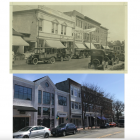There & Then
New Canaan Now & Then: The Opera House
|
Now 80 Main Street, Nichols Opera House was built in 1890 by George Duff Nichols. The original plan for an 850 person auditorium was to be the new Town Hall, but the Town decided it did not need one. Nonetheless, the Opera House became the de facto town hall. On either side of the entrance to the opera house, Nichols also had two storefronts built. A few months before the building was even finished, the southern storefront had already been rented out to the town for $350 a month. When the building was finished in December of 1890, it was the location for the town clerk’s office, the selectman’s office, and, with three jail cells in the basement, the town jail. All of the town’s important documents were also kept in the fireproof vault that had been installed in the storefront for this purpose. The auditorium was regularly rented out for town meetings and the rented offices were sometimes used as a courtroom.
When it first opened, the Nichols Opera House could compete with the finest in the state. The stage, the backdrops, and the dressing rooms were top quality. There was even a banquet hall in the basement. It was also the first building to be electrified in New Canaan. The first show held there,”Annette, the Dancing Girl”, opened on December 23, 1890. Shows were also held on the following day, Christmas Eve, with a banquet starting at 12:30 am. In order to accommodate the out of towners, Nichols arranged for an extra train to leave New Canaan at 11:30 pm. However this sort of event did not last long. It quickly became apparent that a small town such as New Canaan could not support an opera house. Within a year, the opera house was mostly hosting plays put on by local companies, and local events. No operas were actually ever performed here. Unsurprisingly, the underground banquet hall did not prove to be successful, so Nichols converted the space into a corset and underwear factory. The electric lights also did not last long. After two months, Nichols had the building converted to gas light fixtures. It was most likely too expensive to run the generator needed to power the building.
